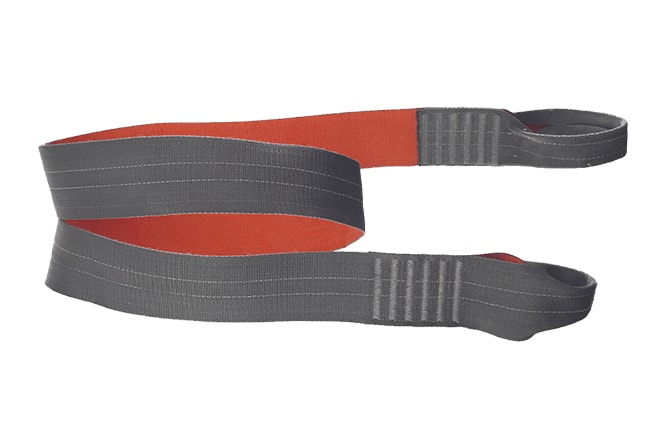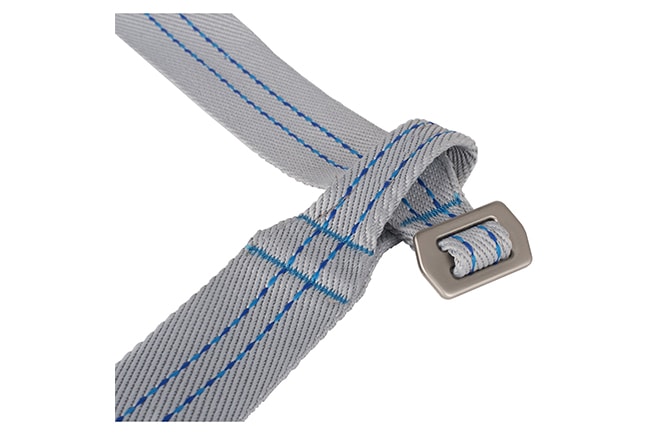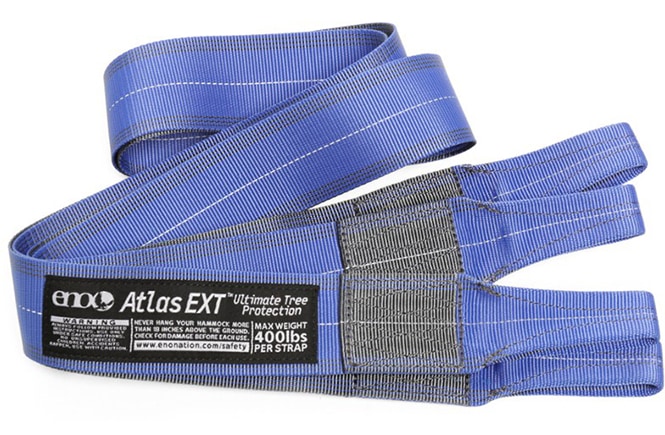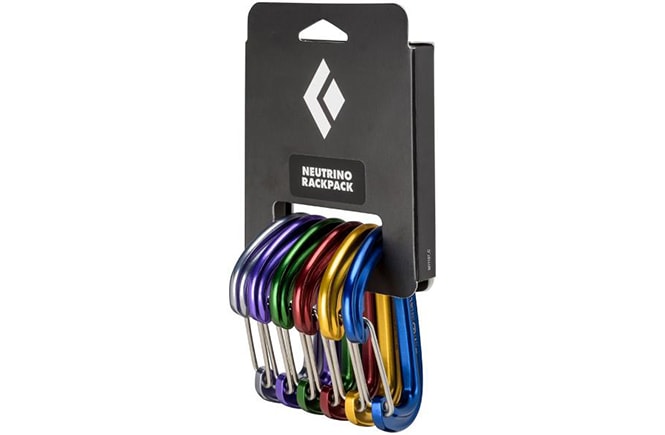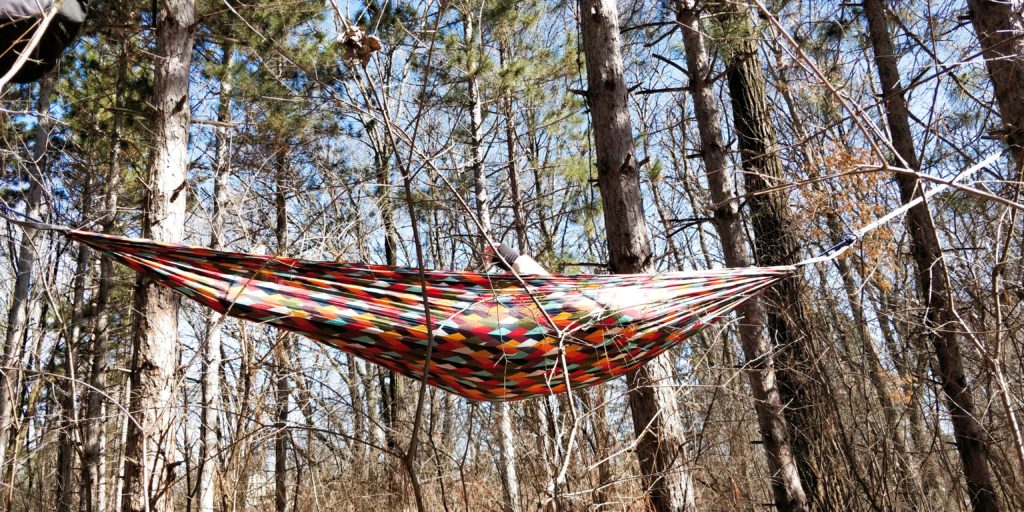 When you buy something using links in our stories, we may earn a small commission. Read more about our policy.
When you buy something using links in our stories, we may earn a small commission. Read more about our policy.
Let’s talk about hammock suspension systems for a moment. That’s just a fancy way of saying how to hang a hammock. Depending on how you plan to use your hammock, there are a few different ways to hang it.
Straps and carabiners—or buckles, which work quite well in Sea to Summit’s hammocks—are the most popular hammock suspension system. It’s pretty standard for most gathered-end nylon hammocks, AKA parachute hammocks since it’s made of the same heavy duty material as parachutes. These have become super popular given how affordable, lightweight, comfortable, and easy they are to setup and take down.
If you have a small, portable hammock that you want to take camping or hiking, securely and safely suspending is really quite simple. All you’ll need are some tree straps for the hammock and carabiners, the clips that attach the hammock to the strap.
It’s important to note that we do not recommend hanging a hammock with rope. Thin rope digs into trees and damages the bark. Many state and national parks actually have regulations around how you can hang hammocks—especially when it comes to straps. For example, in many state and national parks, straps must be at least 1″ thick.
Do hammocks come with straps?
Some hammocks come with straps, but most do not, so you’ll likely need to purchase them separately. However, most hammocks do come with carabiners so generally you don’t need to buy those unless you want extras for hanging gear off your hammock straps or using around camp. They’re pretty handy in general, so doesn’t hurt to have some extra carabiners.
Other hammocks may come with built-in straps and buckles instead of carabiners. Check what’s in your kit before going outside and finding out that you’re missing crucial pieces to your hammock setup.
Here, we’ll cover everything you need to know about hanging hammocks with tree straps, like:
- What’s the difference between all the hammock strap options out there? Use the comparison chart below to sort by what matters most to you—whether that’s price, length, weight capacity, etc.
- When would you need a strap extender?
- How far apart should trees be?
- How do hammock straps impact trees? (Thank you for asking!)
How to hang a hammock without trees or straps
There are several other ways to enjoy a hammock, including hammock stands, wall mounts, and folding hammocks with stands.
What to look for in hammock tree straps
Not all hammock straps are created equal. To help protect trees and bark, wider straps are ideal. They are better at dispersing the weight against the tree, vs. having a skinny strap or rope that digs into the tree trunk.
There are a few things to consider when looking at hammock straps:
- Length. The longer, the better. Unless you’re concerned about how much weight you’re carrying. We prefer longer straps when we’re car camping or going on a hike because sometimes trees are farther apart and you’ll need some extra length. Or, a tree might have a large trunk and take up more strap length. If you are concerned about pack weight, you could purchase shorter/lighter straps and extenders separately to use when you can load up the car or daypack.
- Weight. If you’re backpacking or even hiking, you will want to consider the weight of the straps, as every ounce adds up.
- Strength. Check to see how much the strap can hold. In our six yeas of hammocking, we’ve never had a strap break, rip, or even begin to tear. Most reputable brands are selling quality products. That doesn’t go for the cheap hammocks on Amazon. Also check to see how much weight your hammock can hold to make sure it’s all copacetic.
- Durability. Most of the bigger brands offer warrantees on their gear, including hammock straps. Find one that does, and should anything happen, they can replace it. Again, we’ve never had this problem, but we haven’t tried every strap out there. Also, we don’t hammock camp too often. If you’ll be sleeping overnight in your hammock, you definitely want to make sure it’s a quality strap that can withstand lots of use.
How far apart do trees need to be?
This depends on how long your hammock and straps are, combined. Below, we break down popular straps by length and other pertinent details in the comparison chart.
But let’s say you have an ENO Double Nest hammock (74″) and ENO’s Atlas Hammock straps (108″ x 2), you have just over 24 feet of total length. Don’t forget to factor in the fact that the straps have to loop around both trees, so look for trees no more than 20 feet apart. Depending on how big the trees are—and how much strap is required—you may be better off looking for trees around 15-18′ feet apart, which will give you a bit of slack for the hammock, creating that lovely, comfortable banana shape.
While the Atlas Hammock straps give you exactly 9 feet on either end, ENO’s Atlas XL Hammock Straps are each over 13.5 feet.
On the flip side, trees can be as close together as roughly 7′ for a comfortable hang. Using the ENO hammock again as an example, it is over 6 feet long, and you want a little room on either end to clip it in. You can hang from trees that are closer together than this, but your hammock won’t be able to stretch out, which is great for sitting upright and swinging but not exactly comfortable to lie down in.
Comparison chart of the top brands’ hammock straps
This chart doesn’t include every hammock strap on the market. It does include the most reputable hammock brands and a few cheaper options on Amazon, which is an endless pit of hammock accessories. If you want to invest in high-quality gear, check out these straps.
Not every strap is created equal. Depending on how you will use your hammock and what’s important (price, weight, length, etc.), you can narrow down your choices here.
*Note: prices were accurate at the time of publishing. Sometimes things go on sale or prices change. To see today’s price, click on the photo, brand, or product name.
| Photo | Brand | Product | Price | Capacity | Length | Weight | Loops | Description |
|---|---|---|---|---|---|---|---|---|
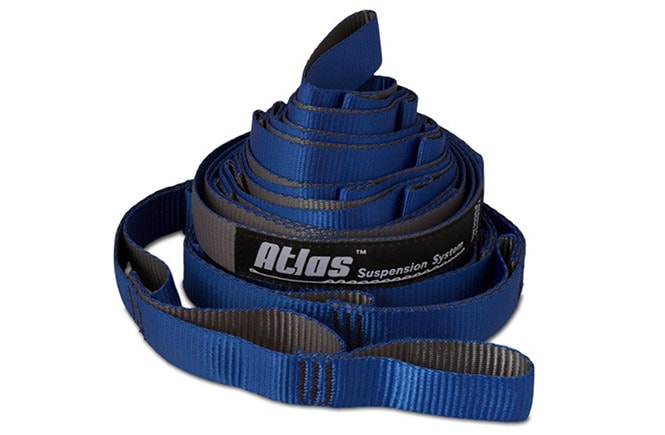 | ENO | Atlas Chroma Suspension System | $34.95 | 400 lbs | 09' | 11 oz | 15 on each strap | These are ENO's original hammock strap. They're slightly cheaper than other models and weigh slightly more. Overall a great choice for everyday hammock straps. |
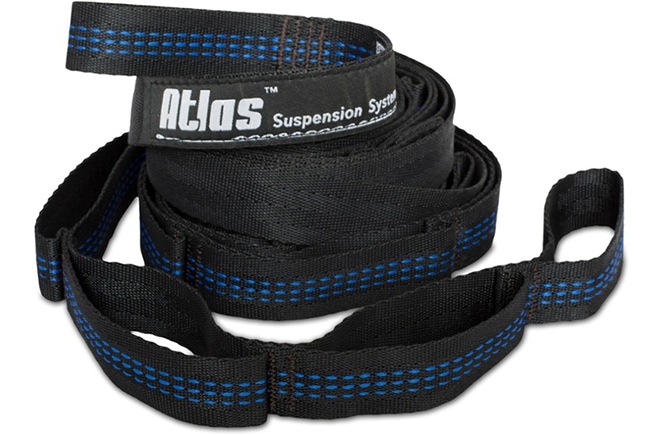 | ENO | Atlas Suspension System | $29.95 | 400 lbs | 09' | 09 oz | 15 on each strap | The new model of the tried and true Atlas strap has a tapered design with a slightly wider strap around the important part of the tree, offering a bit of extra protection by helping to disperse the weight. |
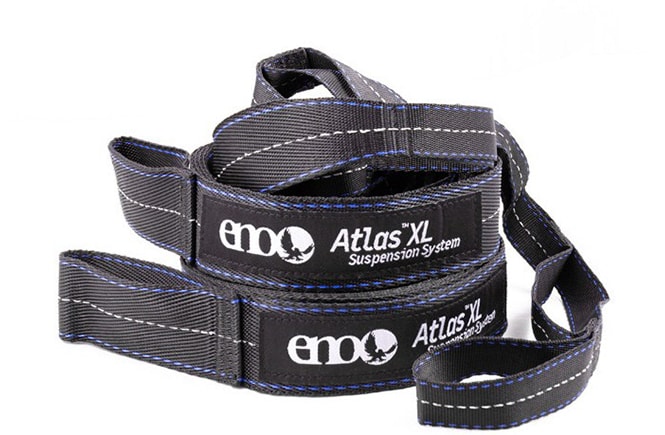 | ENO | Atlas XL Suspension System | $39.95 | 400 lbs | 13'7" | 13 oz | 20 on each strap | With more loops and 3'6" more length, these longer straps are great for any adventures that may have far-apart trees or large trees. |
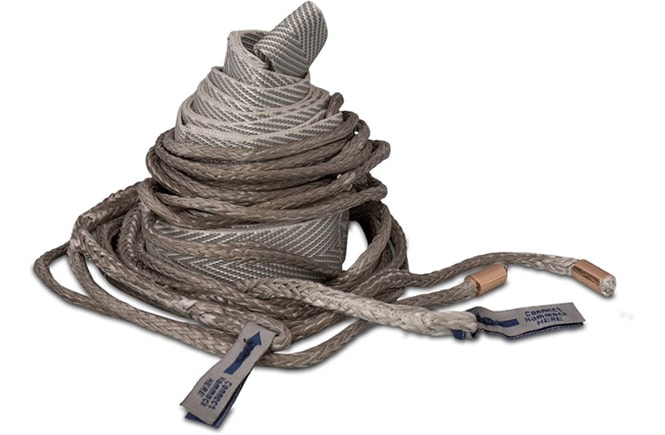 | ENO | Helios Ultralight Suspension System | $34.95 | 300 lbs | 08' | 04.3 oz | Not specified | ENO's most lightweight option. |
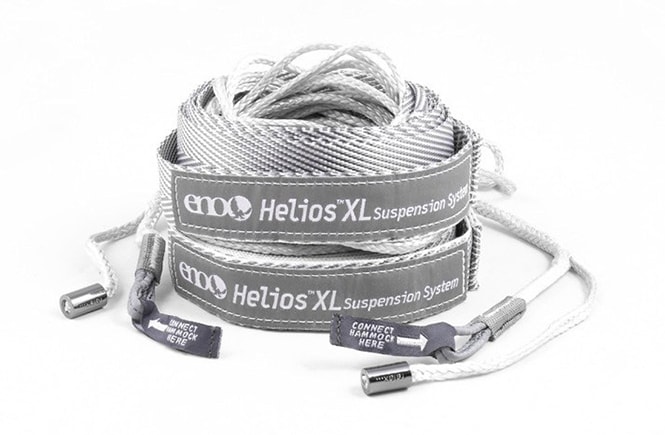 | ENO | Helios XL Ultralight Suspension System | $44.95 | 300 lbs | 13'5" | 06.3 oz | Not specified | When you need long straps but are watching your weight. |
 | Grand Trunk | Trunk Straps | $29.95 | 400 lbs | 10' | 12 oz | 18 on each strap | Grand Trunk straps come in a few bold colors and happen to match a lot of their designs. If you're looking for fun and flashy, these are the straps for you. They also offer a lifetime warranty and will replace any strap that breaks. |
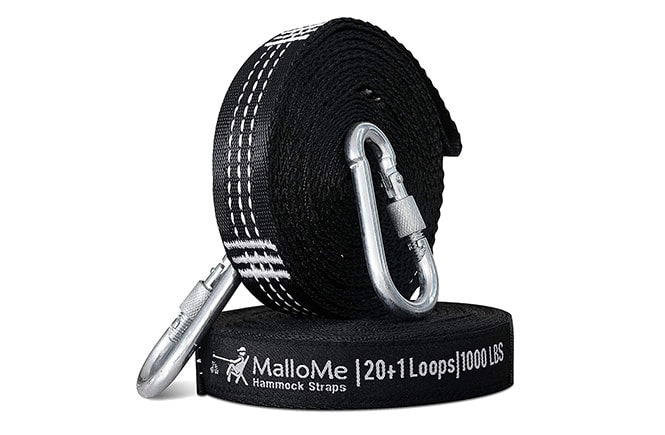 | MalloMe | XL Hammock Straps | $19.99 | 2,000 lbs | 12' | 19 oz | 20 on each strap | Not that you're putting a cow in the hammock, but you could with these straps. They apparently hold up to 2,000 lbs, which seems crazy and totally unnecessary. Regardless, great straps for a great price. |
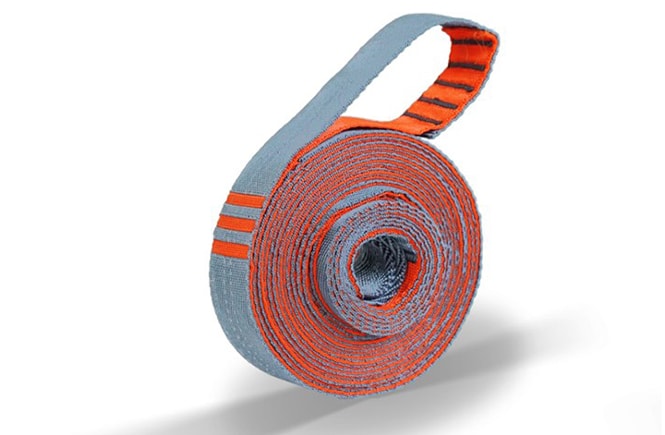 | Kammok | Python 10 Hammock Straps | $29.00 | 500 lbs | 10' | 08.2 oz | 20 on each strap | Kammok makes quality gear, though we've found that their hammock straps are some of the thinnest, which is not ideal for the trees as it causes the weight to be concentrated on a smaller area and therefore dig harder into the tree trunk and can potentially damage the bark. |
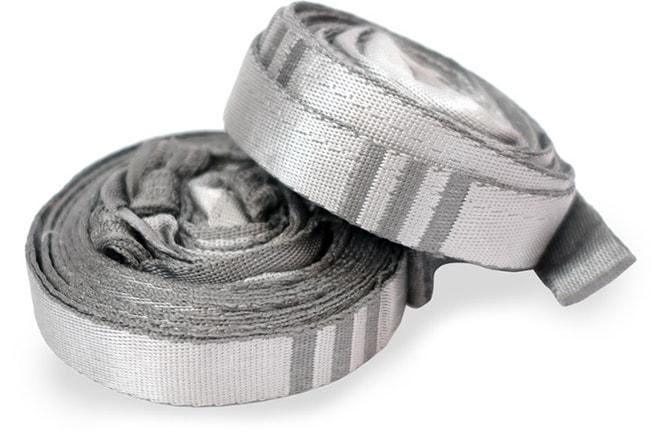 | Kammok | Python 10 Ultralight Hammock Straps | $39.00 | 300 lbs | 10' | 03.2 oz | 20 on each strap | Kammok's lightweight model clocks in just under ENO's, and they're longer. |
 | Kammok | Python 15 Hammock Straps | $39.00 | 500 lbs | 15' | 11.8 oz | 33 on each strap | The longest straps on the market and most loop options, meaning you can get your hammock exactly as you want. |
 | Hummingbird Hammocks | Tree Straps | $29.95 | 400 lbs | 08'4" | 01.55 oz | No loops needed with whoopie slings | How are these so lightweight? It's Hummingbird's specialty. These straps combine 1" webbing (for the part that goes around the tree) with rope (to save on ounces). A "whoopie sling" system locks the rope in in place with the same advanced technology from your childhood: the Chinese Finger Trap. |
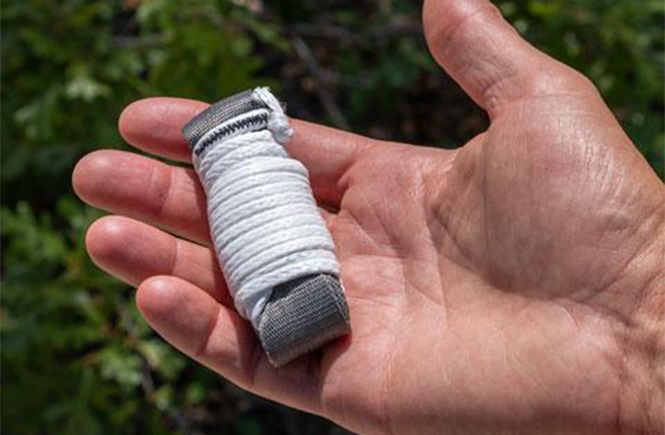 | Hummingbird Hammocks | Tree Straps+ | $39.95 | 400 lbs | 12'7" | 02.3 oz | No loops needed with whoopie slings | Same technology as Hummingbird's regular tree straps, just longer. |
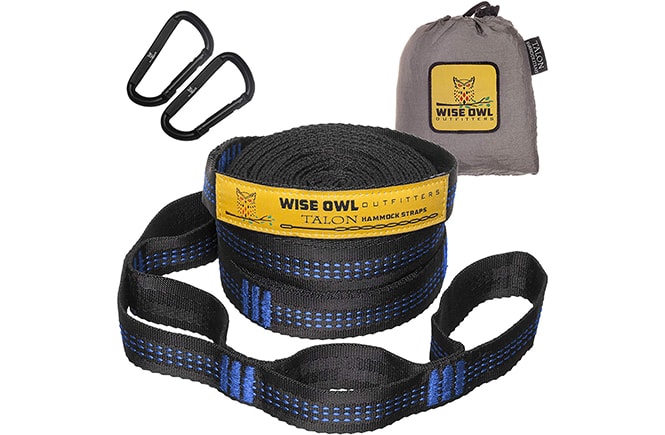 | Wise Owl Outfitters | Talon XL Hammock Tree Straps | $21.49 | 500 lbs | 10' | 15 oz | 19 on each strap | Wise Owl is one company that sells straps with their hammocks, but should you find yourself in the market for longer straps, they do sell an XL version (though it's only 1" longer and not as long as other brands' XL straps). They're a good option if you're on a budget. |
 | Therm-a-Rest | Slacker Suspenders Hanging Kit | $29.95 | 400 lbs | 10'6" | 09 oz | No loops needed with adjustable buckles | A universal strap with buckle that can be used with any hammock. The loop on one end of the strap goes into the carabiner, and you tighten the buckle from the other end to any desired length. |
Hammock strap extenders + tree protectors
There are some pretty long straps out there, but sometimes you just need more room to work with. Enter: the strap extenders.
These straps can add crucial length to your hang setup, which comes in handy not only when trees are far apart. Sometimes you find yourself around some big ass trees. Those wide trunks take up a lot of strap real estate and before you know it, you used your entire strap just to get around the tree and have nothing left to clip onto. Latch these extenders onto your straps to get even more length and flexibility while hanging.
They also help protect the trees. Some straps are pretty thin and narrow, and this is not ideal for our living, breathing forest friends. When all of the weight of the hammock is concentrated in a small area wrapping around the tree trunk, the strap tends to dig into the bark and damage the tree. With the rise in popularity of hammocks, it’s important we’re all doing our part to protect the trees. They’re strong, but they’re not unbreakable beings.
Kammock Python Extenders
These Python Extenders add 9′ of distance to your hammock straps, which is pretty impressive. But even better than that is the fact that they’re 2″ wide and help to disperse the weight of the hammock around the tree, sparing the trunk and bark from damage. The loops are also designed to always remain open, which helps pull the straps through.
Sea to Summit Hammock Tree Protectors
Sea to Summit is one of the brands that uses buckle technology to hang instead of carabiners. These tree protector straps add 5 feet of length and are 1.5″ wide. They easily attach to existing straps. When not in use, they pack down pretty small inside their own carrying case, weighing just 4.8 oz. The straps are made of high tenacity, non-stretch webbing and can hold up to 400 lbs.
ENO Atlas EXT Ultimate Tree Protection
These extra-wide straps measure in at 2″ and are designed to wrap around the tree, while you clip the traditional strap into its end. While protecting the trees, you’re adding 10 feet of length to your hammock suspension system. The reflective stitching helps provide visibility at night. Weighing just 7 oz, the straps are made from 1000-denier polyfilament webbing and can hold up to 400 lbs.
Carabiners
Most hammocks come with carabiners. If yours doesn’t, it will likely have ropes at each end with loops to easily slip onto a carabiner. This is how you’ll fix the hammock to the straps, so it’s a pretty important piece of gear. You can get them for pretty cheap. You might also want a few extra carabiners to hang gear off the straps.
Other ways to hang a hammock
Straps rely on trees or posts to hang from. If you don’t have trees—or if you are looking for something a little more permanent—you may want to invest in a hammock stand. While stands aren’t as portable as straps, they do have more flexibility in that you can set up anywhere. If you don’t have trees—or don’t have enough trees—a free-standing hammock stand is a great option. There are several different types, shapes, sizes, price points. There are stands that hold one hammock, two, or more.
There are also indoor hammock hanging kits if you want to post up in your bedroom. These are designed to go straight into your drywall—through a wooden stud, of course—and are less intrusive than a hammock stand. You can easily clip off the hammock when it’s not in use.
Finally, another easy way to hang is with a folding hammock that comes with its own collapsable stand. These are great for camping and many act like cots. You can bring them into your tent with you at night, and most are more portable than the hammock stands mentioned above.

